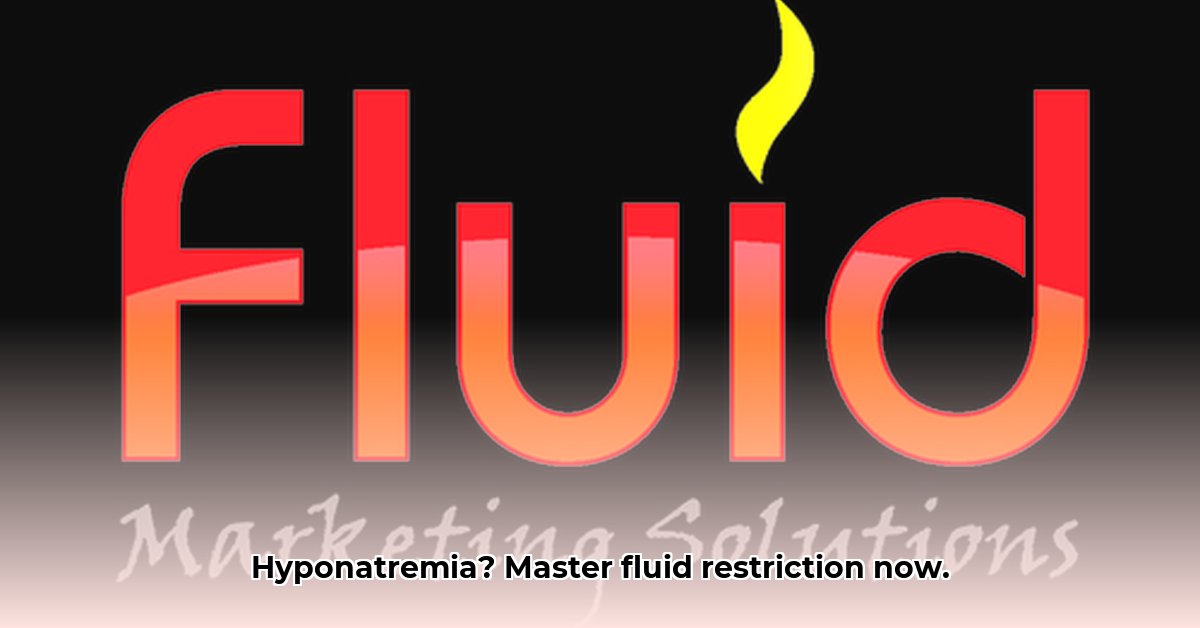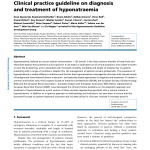Low sodium in your blood (hyponatremia) is a serious issue that needs careful handling. Sometimes, the best way to treat it is by limiting how much fluid you drink. For more detailed guidelines, see the Hyponatremia Treatment Guidelines. This guide will walk you through everything you need to know about managing hyponatremia with fluid restriction – from understanding the condition, to safely and effectively limiting fluids, to knowing what to watch out for. We’ll cover the potential pitfalls and how to avoid them, so you can confidently make a plan for managing hyponatremia. Whether you’re a healthcare professional or a patient learning to manage your condition, this guide will give you the clear, actionable information you need.
Fluid Restriction for Hyponatremia: A Practical Guide
Hyponatremia – low sodium in your blood – is a common problem, generally defined as a plasma sodium level of less than 135 mEq per L (135 mmol per L), that needs careful attention. Managing it involves figuring out the reason for the low sodium, checking how much fluid your body has, and choosing the right treatment. Often, limiting fluid intake is a key part of treatment, but it’s not a one-size-fits-all solution. Let’s explore when it helps and how to do it safely in effective hyponatremia management.
Understanding Fluid Restriction for Hyponatremia: The Basics
Fluid restriction mainly helps with a type of hyponatremia called “euvolemic hyponatremia.” This means your body has the right amount of fluid overall, but the sodium is diluted because there’s too much water. Think of it like making soup – you have the right amount of ingredients, but you added too much broth. Limiting fluids helps your kidneys get rid of extra water, gradually increasing the sodium concentration in your blood. Euvolemic hyponatremia often presents with nonspecific symptoms like headache, lethargy, or nausea. In severe cases, neurologic symptoms such as seizures and coma can occur. What are the signs of euvolemic hyponatremia to watch out for?
However, it’s not as simple as just drinking less. The amount of fluid you need to restrict varies greatly depending on your overall health and how severe your hyponatremia is. Restricting fluids too much can lead to dehydration, which is harmful. It’s also crucial to consider that hyponatremia can sometimes be a sign of underlying conditions like hypothyroidism or adrenal insufficiency, which need to be addressed separately.
Who Benefits from Fluid Restriction?
Before limiting fluids, doctors need to figure out what kind of hyponatremia you have. There are three main types, each requiring a different management strategy:
- Hypovolemic: Your body is low on overall fluid and sodium. This can be caused by vomiting, diarrhea, or diuretic use. Fluid restriction isn’t usually the first choice here; the focus is on replacing lost fluids.
- Euvolemic: Your overall fluid levels are normal, but the sodium is diluted. This is the type most likely to benefit from fluid restriction. Causes can include SIADH (syndrome of inappropriate antidiuretic hormone secretion) or excessive water intake.
- Hypervolemic: Your body has too much fluid and sodium, but the increase in fluid is disproportionately greater. Conditions like heart failure, cirrhosis, and renal failure can cause this. Limiting fluids here might not be enough, and other treatments like diuretics are often necessary.
Doctors use physical exams, blood tests, and urine tests to determine which type you have. Plasma osmolality and urine sodium concentration are particularly useful in differentiating between hypovolemic and euvolemic hyponatremia. Getting the right diagnosis is crucial; a wrong diagnosis could lead to the wrong treatment and harm. Even if you have euvolemic hyponatremia, more evaluation is usually needed to create a safe plan. What specific blood tests help determine hyponatremia type?
A Step-by-Step Guide to Fluid Restriction
Successfully managing hyponatremia with fluid restriction often involves a gradual approach, tailored to the individual patient:
- Accurate Diagnosis: Your doctor will confirm the diagnosis of euvolemic hyponatremia through a thorough check-up and blood tests, including plasma and urine osmolality measurements. This is the cornerstone of safe treatment.
- Personalized Plan: Your doctor creates a fluid restriction plan tailored to your specific needs. They’ll consider things like your age, other health conditions, medications you’re taking, and how low your sodium levels are. A typical fluid restriction might start at 1 to 1.5 liters per day, but this varies. Close monitoring is essential.
- Gradual Reduction: You’ll likely start by slightly reducing your daily fluid intake. Your doctor will gradually decrease the amount allowed as your sodium levels improve. Making drastic changes too quickly can create other problems.
- Regular Check-ups: You’ll have regular blood tests to check your sodium levels, and your doctor will monitor your urine output and overall health. This allows for timely adjustment of the plan. Monitoring frequency depends on the severity of hyponatremia and the patient’s response to treatment.
- Patient Education: You and your family will learn about the importance of following the plan, what to watch out for in terms of dehydration or worsening hyponatremia, and the need for regular follow-up appointments. Understanding the rationale behind fluid restriction is key to compliance.
Monitoring and Potential Risks
Regular monitoring of your sodium levels is vital. Correcting hyponatremia too quickly (more than 8-12 mEq/L in 24 hours) can be dangerous and potentially lead to osmotic demyelination syndrome (ODS), a serious neurological condition affecting the brain. On the other hand, correcting it too slowly could delay your recovery. Regular check-ups allow your doctor to make adjustments ensuring your safety. What are the long-term neurological consequences of osmotic demyelination syndrome (ODS)?
Symptoms of ODS can include confusion, speech difficulties, paralysis, and even death. Prompt recognition and management are crucial.
When Fluid Restriction Alone Isn’t Enough
For some people, simply restricting fluids may not be enough to raise sodium levels. If your sodium levels don’t improve adequately or if you continue to have symptoms, your doctor might add other treatments, such as medications that help your body get rid of extra water (like diuretics or vaptans), or address any underlying causes of your hyponatremia, such as SIADH or adrenal insufficiency. Remember, personalized treatment plans are key to successful management.
Looking at the Bigger Picture
Fluid restriction is just one piece of the puzzle in managing hyponatremia. It’s crucial to treat any other medical conditions that might be contributing to low sodium levels and to prevent it from happening again. This may involve managing heart failure, adjusting medications that can cause hyponatremia, or addressing hormonal imbalances. The best results come from a close partnership between you and your healthcare team. How does managing underlying conditions impact hyponatremia recurrence?
Effective management of underlying conditions often reduces the risk of future hyponatremia episodes.
Ongoing Research and Future Directions
While the information provided offers a comprehensive current understanding of fluid restriction for hyponatremia management, ongoing research continues to refine our approach. New findings might lead to adjustments in recommended practices. It’s advisable to stay updated on the latest medical literature and consult your healthcare professional regularly for optimal care. The field is constantly evolving, with ongoing investigation into personalized treatment strategies and innovative therapeutic approaches. This means that the best approach might change over time, based on new discoveries. Recent research has focused on the role of specific biomarkers in predicting response to different treatments and on developing more targeted therapies for SIADH.
How to choose between vaptans and traditional treatments for hyponatremia
Key Takeaways:
- Hyponatremia, characterized by low sodium levels (typically less than 135 mEq/L), needs tailored treatment based on its cause and the patient’s fluid status.
- Vaptans, a type of medication, increase water excretion without significant electrolyte loss. They’re often effective in certain hyponatremia types, particularly euvolemic and hypervolemic hyponatremia caused by SIADH.
- Traditional treatments involve fluid restriction or intravenous fluids; the choice depends on the individual’s needs.
- Careful monitoring is crucial to prevent rapid sodium correction, which can cause serious side effects like osmotic demyelination syndrome (ODS).
- Shared decision-making between healthcare provider and patient ensures the best treatment plan.
Understanding Hyponatremia and Treatment Options
Hyponatremia, a common electrolyte imbalance, leaves you with low sodium levels in your blood. This seemingly simple condition has various causes, broadly categorized by fluid volume status: hypovolemic (low blood volume), euvolemic (normal blood volume), and hypervolemic (high blood volume). Treatment depends critically on correctly identifying the underlying cause and the patient’s fluid status. That leads us to the central question: How to choose between vaptans and traditional treatments for hyponatremia? Electrolyte imbalances often disrupt the body’s normal physiological processes, and hyponatremia is a prime example of this disruption. What is the correlation between electrolyte imbalance and hyponatremia?
Hyponatremia reflects an imbalance between total body water and total body sodium, impacting cellular function and overall health.
Vaptans: A Targeted Approach
Vaptans, specifically tolvaptan and conivapt
- Wellness Fair Ideas for Work to Boost Employee Wellbeing - December 15, 2025
- Affordable Employee Wellness Fair Ideas for Any Budget - December 14, 2025
- Employee Wellness Programs Strategically Benefit Employee Health And Retention - December 13, 2025
















